 W
WAcropora muricata, commonly called staghorn coral, is a species of acroporid coral found in the Gulf of Aden, the Red Sea, Indian Ocean, Persian Gulf, Australia, central Indo-Pacific, Japan, Southeast Asia, the East China Sea and the oceanic central and western Pacific Ocean. It is found in tropical shallow reefs, slopes of reefs, and in lagoons, from depths of 5 to 30 m. It was described by Dana in 1846.
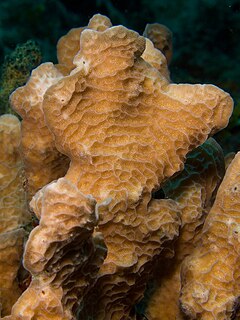 W
WAgaricia agaricites, commonly known as lettuce coral or tan lettuce-leaf coral, is a species of colonial stony corals in the family Agariciidae. This coral is found in shallow waters in the tropical western Atlantic Ocean and the Caribbean Sea. It is a common species and the IUCN has assessed its status as being of "least concern".
 W
WAlcyonium digitatum or dead man's fingers is a species of soft coral in the family Alcyoniidae. It is found around the coasts of the northern Atlantic Ocean.
 W
WCladocora caespitosa, commonly known as cushion coral, is a stony coral of the subclass Hexacorallia. This species forms the only true coral reef in the Mediterranean Sea.
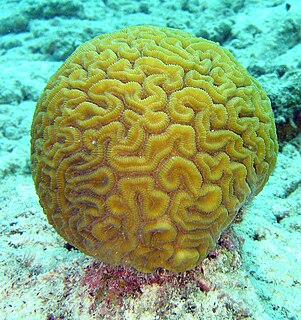 W
WDiploria is a monotypic genus of massive reef building stony corals in the family Mussidae. It is represented by a single species, Diploria labyrinthiformis, commonly known as grooved brain coral and is found in the western Atlantic Ocean and Caribbean Sea. It has a familiar, maze-like appearance.
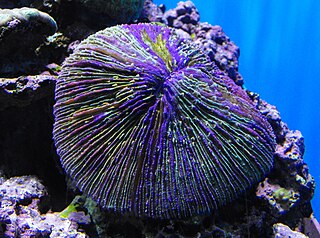 W
WFungia is a genus of corals in the family Fungiidae. It is monotypic with the single species Fungia fungites, which is found growing on reefs in the Indo-Pacific.
 W
WGorgonia flabellum, also known as the Venus fan, Venus sea fan, common sea fan, West Indian sea fan, and purple gorgonian seafan, is a species of sea fan, a sessile colonial soft coral.
 W
WGorgonia ventalina, the purple sea fan, is a species of sea fan, an octocoral in the family Gorgoniidae. It is found in the western Atlantic Ocean and the Caribbean Sea.
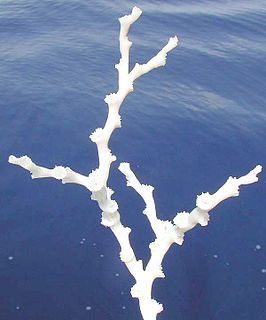 W
WLophelia pertusa, the only species in the genus Lophelia, is a cold-water coral which grows in the deep waters throughout the North Atlantic ocean, as well as parts of the Caribbean Sea and Alboran Sea. L. pertusa reefs are home to a diverse community, however the species is extremely slow growing and may be harmed by destructive fishing practices, or oil exploration and extraction.
 W
WLophelia pertusa, the only species in the genus Lophelia, is a cold-water coral which grows in the deep waters throughout the North Atlantic ocean, as well as parts of the Caribbean Sea and Alboran Sea. L. pertusa reefs are home to a diverse community, however the species is extremely slow growing and may be harmed by destructive fishing practices, or oil exploration and extraction.
 W
WMadrepora oculata, also called zigzag coral, is a stony coral that is found worldwide outside of the polar regions, growing in deep water at depths of 80–1500 meters. It was first described by Carl Linnaeus in his landmark 1758 10th edition of Systema Naturae. It is one of only 12 species of coral that are found worldwide, including in Subantarctic oceans. In some areas, such as in the Mediterranean Sea and the North-east Atlantic Ocean, it dominates communities of coral.
 W
WMeandrina meandrites, commonly known as maze coral, is a species of colonial stony coral in the family Meandrinidae. It is found primarily on outer coral reef slopes in the Caribbean Sea and the Gulf of Mexico.
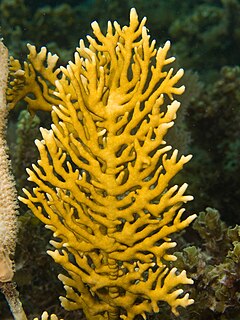 W
WMillepora alcicornis, or sea ginger, is a species of colonial fire coral with a calcareous skeleton. It is found on shallow water coral reefs in the tropical west Atlantic Ocean. It shows a variety of different morphologies depending on its location. It feeds on plankton and derives part of its energy requirements from microalgae found within its tissues. It is an important member of the reef building community and subject to the same threats as other corals. It can cause painful stings to unwary divers.
 W
WThe Organ pipe coral is an alcyonarian coral native to the waters of the Indian Ocean and the central and western regions of the Pacific Ocean. It is the only known species of the genus Tubipora. This species is a soft coral but with a unique, hard skeleton of calcium carbonate that contains many organ pipe-like tubes. On each tube is a series of polyps which each have eight feather-like tentacles. These tentacles are usually extended during the day, but will swiftly withdraw with any sort of disturbance. The skeleton is a bright red color, but is typically obscured by the numerous polyps, which are green or gray in color. In size, colonies can reach up to a meter across, while the individual polyps are typically less than 3 mm wide and a few mm long. They are restricted to shallow waters and tend to live in sheltered areas where they eat plankton. They are close relatives to other soft coral and sea fans. This species is sometimes kept in aquariums, but is temperamental, and is difficult to maintain.
 W
WParagorgia arborea is a species of coral in the family Paragorgiidae, commonly known as the bubblegum coral because of its bulbous branch tips. It mainly grows in depths between 200 and 1,300 metres at temperatures between 3 and 8 °C. It is found widespread in the Northern Atlantic Ocean and Northern Pacific Ocean on seamounts and knolls, and was first described by the Swedish naturalist Carl Linnaeus in 1758. P. arborea is a foundation species, providing a habitat for other species in deep sea coral ecosystems.
 W
WPocillopora damicornis, commonly known as the cauliflower coral or lace coral, is a species of stony coral in the family Pocilloporidae. It is native to tropical and subtropical parts of the Indian and Pacific Oceans.